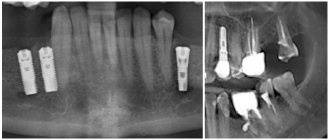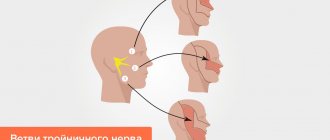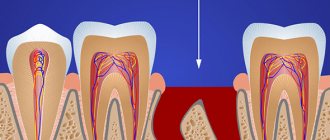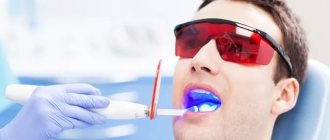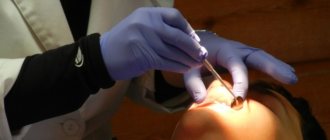Why does my head hurt after tooth extraction?
Tooth extraction is an operation in which the integrity of the gums is disrupted. After it, a hole remains, and during the intervention, blood vessels, nerves, and soft tissues are damaged. It is important that complete healing can take up to 7 days. Over time, the patient may experience pain during meals, as well as during the day. Discomfort often extends not only to the damaged area, but also to the entire surface of the head.
It is considered normal if the hole gradually decreases and the pain becomes less intense. If it remains acute, inflammation on the gums increases, additional symptoms appear - this may indicate the development of complications. Some of them occur directly during surgery:
- an overly branched system of tooth roots, which leads to tissue trauma, including jaw bones;
- a large tooth, after the removal of which a wide hole remains - the recovery period is the longest after the extraction of wisdom teeth;
- the presence of an abscess under the root of the tooth - to remove the pus and clean the abscess cavity, it is necessary to cut the gum;
- insufficient surgical access, as a result of which fragments of dental tissue, cotton wool and other materials may remain in the hole - this leads to inflammation and suppuration.
Postoperative complications are also distinguished. They occur a few days after tooth extraction and are accompanied by intense toothache and headache. It is important to seek medical help promptly and begin treatment.
Alveolitis
Alveolitis is an infectious inflammation of the postoperative socket. It can be caused by staphylococci, streptococci and other pathogenic microorganisms. It is important that they are found in large quantities in the oral cavity, so it is important to carefully treat the wound. Alveolitis is accompanied by characteristic symptoms:
- acute toothache and headache;
- redness and swelling of the gums;
- increased temperature;
- weakness, muscle aches.
One of the common causes of alveolitis is the removal of a blood clot, which is normally located in the wound in the first few days. It is not recommended to remove or move it, since it protects the open wound from pathogenic microorganisms. In addition, inflammation can occur due to poor wound treatment. At the first signs of alveolitis, it is important to consult a dentist for socket sanitation and anti-inflammatory therapy. Lack of treatment can lead to osteomyelitis - this is a dangerous disease that causes destruction of the jaw bones and infection in the bloodstream.
Dry socket
Dry socket is a common complication, especially after wisdom tooth extraction. It is diagnosed when a blood clot is removed prematurely, exposing an open wound, damaged tissue and even bone. This leads to the entry of pathogenic microflora and purulent inflammation. If the blood clot is removed on its own within the first 5 days, cotton wool or gauze soaked in an antibacterial solution is placed in the hole. This will help avoid purulent complications, acute pain and prolonged wound healing.
Inflammation of the trigeminal nerve
The trigeminal nerve is the largest of the 12 pairs of cranial nerves. Its branches are involved in the innervation of the upper and lower jaws, facial muscles, as well as the eye and forehead areas. Trigeminal neuritis is a dangerous disease that is accompanied by acute pain and other characteristic symptoms:
- sensation of pulsation along the nerve, in the temples and eyes;
- numbness, impaired sensitivity of the skin and facial muscles;
- spasms of the masticatory muscles;
- involuntary muscle contractions, especially with severe pain.
Inflammation of the trigeminal nerve can be caused by infection in the tooth socket after its removal. A typical symptom is an exacerbation of pain, pulsation in a certain position, during chewing and talking, when turning or tilting the head. As a result, the patient tries not to touch the damaged area and make a minimum number of movements. Anti-inflammatory, analgesic, and antibacterial therapy is used to treat neuralgia. If necessary, fragments that cause compression (squeezing) of the nerve are removed.
Hematomas
During surgery, blood vessels are damaged, causing blood to leak into surrounding tissue. Hematomas quickly resolve on their own, but in the first few days they can be large and cause severe headaches, redness and inflammation of the gums. However, their condition must be monitored - normally, the hematoma decreases in size or completely disappears in 3-5 days.
Flux
Flux is a purulent inflammation of the periosteum, one of the likely complications. When it appears, swelling and enlargement of the gums occur, and acute toothaches and headaches are observed. Purulent inflammation provokes redness of the surrounding tissues, an increase in local and general temperature, and shooting pain. Flux requires immediate treatment, as it can cause pus and microorganisms to enter the bloodstream, inflammation of the trigeminal nerve, destruction of the jaw bones and other isolated complications.
Swelling in the face and neck
After surgery, swelling of the soft subcutaneous tissues and lymph nodes may be observed. This is a normal reaction of the body, since tissues and blood vessels are injured during tooth extraction. In addition, during the rehabilitation period, immune defense mechanisms are activated - they prevent the proliferation of pathogenic microorganisms and the development of purulent inflammation. In the first few days, swelling of the face and neck can cause constant headaches. They are dull, of varying degrees of intensity, but disappear after swelling decreases.
Time frame for complete healing after tooth extraction
It is important to understand that tooth extraction is a full-fledged dental operation, after which a period of rehabilitation is required. During this time, the hole heals, pain decreases and the injured area of the gum is restored. There are several main stages:
- The first week after surgery is the period during which the hole is completely filled with granulation tissue. In the first days, a blood clot forms, and on days 4–5, normal granulation forms on top of it. Soreness, swelling, and redness begin to decrease normally within 3–4 days.
- Second week – the recovery process continues. On the 8th day, headaches and toothaches completely disappear, the local temperature of the gums normalizes, and the tooth socket heals. On days 10–14, the process of bone tissue restoration begins.
- The next 1–2 months are the period when intensive growth of bone tissue occurs. It completely fills the hole. However, the bone will become sufficiently strong no earlier than 5–6 months after tooth extraction.
The duration of rehabilitation depends on many features. So, molars have larger roots, which may have an irregular structure, so when they are removed, a large hole remains. Recovery can be lengthy even after removal of incisors or fangs if a cyst or abscess is discovered. It is important to monitor your well-being, but headaches in the first week after surgery are considered a normal reaction of the body.
How to relieve pain and discomfort
- Do not touch the blood clot in the socket with your tongue, toothbrush, hands or foreign objects;
- make oral baths from herbal decoctions and antiseptic solutions;
- if the pain radiates to the ear or another part of the head, take a painkiller;
- exclude hot food and drinks.
If your gums hurt for several days after wisdom tooth removal or you have a headache, you don’t need to worry too much. Analgesics prescribed by your dentist will help you cope with these symptoms. If the discomfort does not go away after a week, painkillers do not help much - you need to go to the doctor. If the temperature is above 37.5℃, which does not decrease to normal, the development of an allergic reaction (to an analgesic, hemostatic sponge), or a sharp deterioration in health, you should consult a doctor immediately.
Methods for diagnosing and treating headaches
When diagnosing, it is important to understand whether the headache was provoked by tooth extraction or whether it was present in the patient before the operation. To do this, a comprehensive examination is carried out, which will include an examination by a dentist and other specialized specialists. Headaches after tooth extraction must be distinguished from trigeminal neuralgia, migraines, traumatic brain injuries and their consequences, and hypertension. An X-ray or MRI of the jaw may be needed to confirm the diagnosis. The images will show dental fragments, cysts and abscesses, as well as other factors that can lead to severe headaches.
The Clinical Brain Institute has all the conditions to undergo a full examination and receive a complete treatment regimen for various cases of headaches. To treat pain in the head and jaw after tooth extraction, the following techniques may be required:
- antibacterial therapy - used to cleanse the wound of pathogenic microflora, as well as to prevent bacteria from entering the wound;
- local drugs with anti-inflammatory and analgesic effects;
- if necessary, socket tamponade;
- surgical techniques - removal of pus and dental fragments, as well as other foreign substances that can provoke an inflammatory reaction and pain.
The basic principles of therapy after tooth extraction are monitoring the proper restoration and healing of the hole, sanitation of the oral cavity and treatment of the open wound from pathogenic microorganisms. If there are complications, including trigeminal neuritis, additional comprehensive treatment will be required. You should consult a doctor if pain and inflammation, swelling and redness of the gums do not decrease within 7 days, and a feeling of throbbing appears. Discomfort in the first week, including headache, is within normal limits.
Prevention methods
Tooth extraction is often required when the 3rd molar (molar) is out of position. However, surgery is also prescribed for caries, abscesses and cysts, and injuries. To prevent caries, you should pay enough attention to oral hygiene, undergo regular dental checkups and clean the enamel from plaque and tartar. Immediately after surgery, it is important to observe several conditions that will help avoid complications and headaches:
- use disinfectant solutions for the oral cavity - they clean the wound from pathogenic microflora;
- take only soft, liquid food in the first few days, so as not to further injure the socket;
- Do not remove a blood clot from the postoperative socket yourself, but if it falls out, consult a doctor.
At the Clinical Brain Institute, you can undergo all the necessary examinations, determine the exact cause of the headache and receive a competent treatment regimen. Our center employs only experienced specialists, general and specialized doctors, as well as modern, precision equipment. There are all conditions for quick and high-quality diagnosis, regular examinations, as well as outpatient and inpatient treatment of headaches.
Wisdom tooth removal: preparation for surgery
A patient wishing to have a wisdom tooth removed requires special preparation. It includes an initial examination and consultation, as well as a number of preparatory measures.
Psychological preparation for surgery is especially important. Most patients are afraid to go for it even in case of urgent need. To overcome a phobia, you should take the time and patience to find a truly experienced, qualified dentist. At the initial consultation, you need to find out from the doctor all the nuances of the procedure, its sequence, preparation measures, the level of pain during and after the operation, etc.
Also, before undergoing surgery, it is important for the patient to pay attention to his own health and level of well-being. If you feel unwell, your visit to the doctor should be cancelled.
It is advisable to eat an hour or two before the operation. This is because the drugs used for local anesthesia can cause fainting if used on an empty stomach, and you will not be able to eat for several hours after the procedure.
If the decision was made to perform the operation under general anesthesia, then, on the contrary, there is no need to eat before the procedure.
